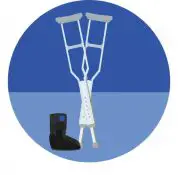Author Interview : Nita Sweeney
I’m happy to introduce Nita Sweeney, an award-winning wellness author of three books, a meditation leader, mental health advocator.
I knew her by chance. Last year my work and life were in trouble due to my hand injury, I came across her book (Depression Hates a Moving Target) by chance and learned that she went from running in 60 seconds to completing a marathon two years later.
Her persistence of spirit encouraged me so that I decided to restart exercise. From the beginning of the slow walk to the current regular exercise, that has restored my mood and life to normal.
I knew she will publish a new book on August 9, so I asked her to give me a short interview.
About Nita Sweeney

Nita Sweeney is the award-winning wellness author of Depression Hates a Moving Target, You Should Be Writing, and Make Every Move a Meditation. UltraMarathoner. Meditator. Writing practice zealot. Mental health advocate. Dog mom. Publisher of Write Now Columbus.
1.I know you have completed 11 books and you also have other jobs. That is a big project. How do you balance writing and life?
Balance. Hmmm. I’m not sure I know the meaning of that. I work in fits and starts. To be clear, I don’t have a day job. I practiced law many years ago, but have not been able to work in a long time due to my mental health challenges.
As for writing, I write in binges, working best with an external deadline. Each November, I typically participate in a challenge called National Novel Writing Month (NaNoWriMo) to write 50,000 words of fiction in the 30 days of November. I usually “rebel” and write nonfiction or revise an existing manuscript. As a result, I’ve completed first or second drafts of 11 books.
2. Is there some time when you want to give up the process of writing this book? How do you keep writing?
A few times I tried to quit writing altogether and only do “writing practice” for my own fulfillment. It didn’t work. I found a deadline, a contest, a challenge, a group, and soon I was writing again.
3. What gave you the idea to write this new book?
My first book, Depression Hates a Moving Target, mentioned meditation a number of times, but did not go into depth about how to meditate. To follow up, my publisher wanted something that would appeal to folks who enjoyed that first book, and I was eager to write about meditation.
As a result, my next book, Make Every Move a Meditation, answers the questions I’m often asked about how I meditate while I exercise. It covers any movement form, and explains centuries-old mindfulness techniques. I hadn’t seen a book quite like it, a memoir-ish, how-to book on meditative movement for mental health. The publisher loved the idea, gave me a deadline, and I got to work.
3. What gave you the idea to write this new book?
My first book, Depression Hates a Moving Target, mentioned meditation a number of times, but did not go into depth about how to meditate. To follow up, my publisher wanted something that would appeal to folks who enjoyed that first book, and I was eager to write about meditation.
As a result, my next book, Make Every Move a Meditation, answers the questions I’m often asked about how I meditate while I exercise. It covers any movement form, and explains centuries-old mindfulness techniques. I hadn’t seen a book quite like it, a memoir-ish, how-to book on meditative movement for mental health. The publisher loved the idea, gave me a deadline, and I got to work.
4. When did you start meditation and what are the benefits of meditation?
There was this guy. *wink*
I met my husband in 1992. One day while we were dating, he asked “Wanna sit?” I said, “Wanna what?” I’d heard of meditation, but not really tried it. He set the microwave timer for 5 minutes and told me “Try not to fidget.” I thought meditation was odd but, I joined him at retreats and meditation groups. As I continued, I began to enjoy the calm and clarity that comes from focused awareness.
Meditation is scientifically proven to have a positive impact on physical, mental, and cognitive health. Studies show meditation does everything from lower blood pressure to ease depression. Like running, meditation is not a cure-all, but every little bit helps.
I most enjoy the benefit meditation has in keeping my mood even. I’m not as reactive. Things that used to irritate me still cause discomfort, but it doesn’t last. Meditating while I move helps me be more relaxed and that improves my performance. My meditation practice also bolsters my writing. The stamina I learned both from running and from long stints of meditation helps me stay at the desk and get the work done.
5.For those who have not been exposed to meditation, it may take a while to experience it when they start to sit quietly in meditation. For these people, can they quickly bring meditation into the movement? What advice do you have for new meditators?
The point of the type of meditation I practice and teach is to be in the moment. In other words, you’re trying to keep your head where your feet are. Most of the time we’re off in a different world, not in this moment, this reality.
Any tool that helps a person bring their attention to the moment they are actually in counts as meditation.
Here are a few of my favorite exercises:
- Feel your butt in the chair when you’re sitting.
- Feel your hands on the steering wheel while you’re driving.
- Notice how your body weight shifts when you walk.
- When your walk through a doorway, feel which foot goes through first.
- Feel your hand on any handle or doorknob you touch during the day.
- Notice all the shades of the color green as you move through the day.
- Notice the sound of birds or wind if you are outside.
- Taste your food, even just one bite.
Pick one thing for the day and see how many times you can be awake to that. When you feel a body sensation, that is in the present moment. That’s what’s here right now. You can use thoughts too, but they are tricky and sticky.
In addition to this present-moment awareness, meditation develops a mind state of equanimity, a balanced mind. We don’t force this. It’s not positive thinking. Meditation creates conditions that allow that quality of mind to develop with practice. We notice when we are judging a sensation. “I don’t like that” or “I want more of that.” During meditation, we try to drop those judgments and let whatever is arising be. It’s a laboratory or a little experiment of seeing if we can be present to whatever is happening without pushing and pulling on that experience.
6. For those who have already been exposed to meditation, is there a trick to better integrate positive awareness into their lives?
The hardest part is remembering to meditate. I tie it to something else.
For example, I have to take a thyroid medication first thing in the morning and wait 30 minutes before I eat breakfast. I use that 30-minute period to meditate. It’s already built in to my schedule and taking the medicine reminds me to practice.
It’s easy for me to remember to meditate while I exercise. I’m already moving, so why not incorporate a session of meditation? I tie them together.
7. Do you have any advice for people who are emotionally troubled right now?
Stay. Hold on. It will change. Get help. Find a teacher. Call a friend. Regardless, in a few moments, a few days, or a year, things will be and feel different. That is a fundamental truth: everything changes.
Thanks to Nita for accepting my interview. If you are interested in her new book “Make Every Move a Meditation“, you can click for further information.
Exercise can be meditation. What do you think of when you hear the word meditation? A quiet room filled with monks? An instagram influencer? What about moving meditation? Yoga? Tai Chi? For too long, meditation in books has focused on specific periods of meditation, rather than mediation through fitness or daily activities. What if lifting weights, dancing with your love, or walking across a room counted? What if you could use exercise as meditation? What if you could make every move a meditation?
Connect with the present moment in each movement. In Make Every Move a Meditation, award-winning author, meditation leader, and mental health advocate Nita Sweeney shows readers that fitness can be mindfulness. She teaches readers how to bring meditation and mindfulness into any activity by incorporating centuries-old techniques. Studies show that both exercise and meditation reduce anxiety, stabilize blood pressure, improve mood and cognition, and lead to a deeper self-relationship and wisdom. Movement is medicine, and meditation is medicine. Let’s combine the two with exercise as meditation.
Inside Make Every Move a Meditation, you’ll learn to:
- Turn exercise into a meditation tool and use exercise as meditation
- Make any activity, even walking through the house, a mindful practice
- Enjoy the benefits of meditation while getting fit
If you like meditation books and best sellers such as Think Like a Monk, Practicing Mindfulness, or Breath, you’ll love Make Every Move a Meditation.

